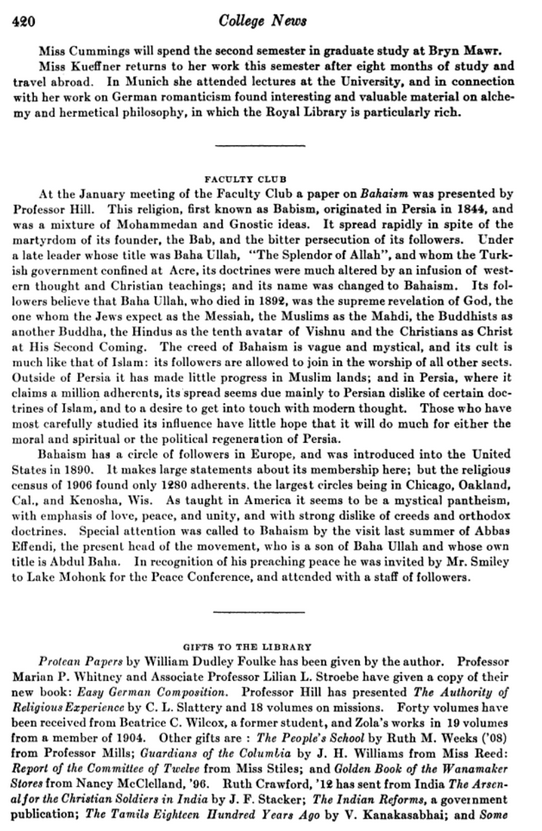
|
|
Abstract: Early Western report on the Bahá'í Faith, notable because it's one of the first references to Bahá'u'lláh being "the tenth avatar of Vishnu," prior to the Guardian's indication of the "tenth avatar... of Krishna" in God Passes By. Notes: From books.google.com. See also news.hrvh.org/veridian and google online e-book. The Professor Hill who presented this paper was possibly Prof. William Bancroft Hill, professor of biblical literature at Vassar College, 1902-1921. He seems to have taken much of his information from Christian missionary sources. |
At the January meeting of the Faculty Club a paper on Bahaism was presented by Professor Hill. This religion, first known as Babism, originated in Persia in 1844, and was a mixture of Mohammedan and Gnostic ideas. It spread rapidly in spite of the martyrdom of its founder, the Bab, and the bitter persecution of its followers. Under a late leader whose title was Baha Ullah, “The Splendor of Allah”, and whom the Turkish government confined at Acre, its doctrines were much altered by an infusion of western thought and Christian teachings; and its name was changed to Bahaism. Its fol lowers believe that Baha Ullah, who died in 1892, was the supreme revelation of God, the one whom the Jews expect as the Messiah, the Muslims as the Mahdi, the Buddhists as another Buddha, the Hindus as the tenth avatar of Vishnu and the Christians as Christ at His Second Coming. The creed of Bahaism is vague and mystical, and its cult is much like that of Islam: its followers are allowed to join in the worship of all other sects. Outside of Persia it has made little progress in Muslim lands; and in Persia, where it claims a million adherents, its ' spread seems due mainly to Persian dislike of certain doctrines of Islam, and to a desire to get into touch with modern thought. Those who have most carefully studied its influence have little hope that it will do much for either the moral and spiritual or the political regeneration of Persia.
Bahaism has a circle of followers in Europe, and was introduced into the United States in 1890. It makes large statements about its membership here; but the religious census of 1906 found only 1280 adherents, the largest circles being in Chicago, Oakland, Cal., and Kenosha, Wis. As taught in America it seems to be a mystical pantheism, with emphasis of love, peace, and unity, and with strong dislike of creeds and orthodox doctrines. Special attention was called to Bahaism by the visit last summer of Abbas Effendi, the present head of the movement, who is a son of Baha Ullah and whose own title is Abdul Baha. In recognition of his preaching peace he was invited by Mr. Smiley to Lake Mohonk for the Peace Conference, and attended with a staff of followers.

|
|